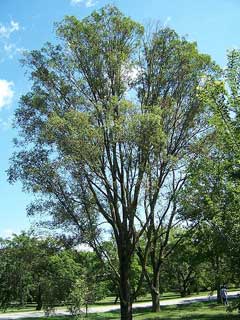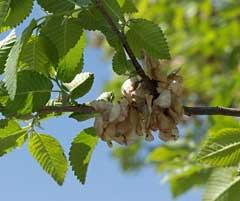 |
|
commons.wikimedia.org/wiki/User:Bruce_Marlin |
 |
| commons.wikimedia.org/wiki/User:Luis_Fernández_García |
Translate this page:
Summary
Bloom Color: Green. Main Bloom Time: Early spring, Late spring, Mid spring. Form: Vase.
Physical Characteristics

 Ulmus pumila is a deciduous Tree growing to 15 m (49ft) by 12 m (39ft) at a fast rate.
Ulmus pumila is a deciduous Tree growing to 15 m (49ft) by 12 m (39ft) at a fast rate.
See above for USDA hardiness. It is hardy to UK zone 3 and is not frost tender. It is in flower in April, and the seeds ripen in May. The species is hermaphrodite (has both male and female organs) and is pollinated by Wind.
Suitable for: light (sandy), medium (loamy) and heavy (clay) soils and prefers well-drained soil. Suitable pH: mildly acid, neutral and basic (mildly alkaline) soils. It can grow in semi-shade (light woodland) or no shade. It prefers dry or moist soil and can tolerate drought. The plant can tolerates strong winds but not maritime exposure.
UK Hardiness Map
US Hardiness Map
Synonyms
Plant Habitats
Woodland Garden Canopy; Secondary;
Edible Uses
Edible Parts: Fruit Inner bark Leaves
Edible Uses:
Leaves - raw or cooked[105, 177, 183]. Used as a potherb[218]. Inner bark - cooked. It can be dried and made into noodles[105, 177, 183]. The dried inner bark can also be ground into a powder and then used as a thickener in soups or added to cereal flours when making bread etc. Fruit - raw or cooked[105, 177]. Used when immature, it can be made into a sauce and a wine[183]. The fruit is about 10mm in diameter[200].
References More on Edible Uses
Medicinal Uses
Plants For A Future can not take any responsibility for any adverse effects from the use of plants. Always seek advice from a professional before using a plant medicinally.
Antibilious Antidote Demulcent Diuretic Febrifuge Lenitive Lithontripic Poultice
The leaves are diuretic and febrifuge[218]. They are used as a pot herb and are then said to be antibilious, antidote and lithontripic[218]. The stem bark is demulcent, diuretic, febrifuge and lenitive[218]. It is mixed with oil and vinegar then used as a poultice on abscesses, mastitis and swellings[218].
References More on Medicinal Uses
The Bookshop: Edible Plant Books
Our Latest books on Perennial Plants For Food Forests and Permaculture Gardens in paperback or digital formats.

Edible Tropical Plants
Food Forest Plants for Hotter Conditions: 250+ Plants For Tropical Food Forests & Permaculture Gardens.
More

Edible Temperate Plants
Plants for Your Food Forest: 500 Plants for Temperate Food Forests & Permaculture Gardens.
More

More Books
PFAF have eight books available in paperback and digital formats. Browse the shop for more information.
Shop Now
Other Uses
Fibre Fodder Shelterbelt Wood
A coarse cloth is made from the inner bark[149]. A fairly wind resistant tree, it can be grown as part of a shelterbelt planting[200]. Wood - hard, heavy, tough, difficult to split. Used for agricultural implements, boat making etc[149].
Special Uses
Carbon Farming
References More on Other Uses
Cultivation details
Agroforestry Services: Windbreak Fodder: Bank Industrial Crop: Biomass Management: Coppice Management: Standard Minor Global Crop
Landscape Uses:Firewood, Aggressive surface roots possible. Prefers a fertile soil in full sun[188], but is easily grown in any soil of at least moderate quality so long as it is well drained[1]. Succeeds in a hot dry position[200]. Established plants are drought resistant[11, 200]. Fairly wind-tolerant[200]. This species, or at least some of its cultivars[200], is resistant to 'Dutch elm disease', a disease that has destroyed the greater part of all the elm trees growing in Britain. The disease is spread by means of beetles. There is no effective cure (1992) for the problem, but most E. Asian, though not Himalayan, species are resistant (though not immune) to the disease so the potential exists to use these resistant species to develop new resistant hybrids with the native species[200]. The various species of this genus hybridize freely with each other and pollen is easily saved, so even those species with different flowering times can be hybridized[200]. Special Features:Not North American native, Invasive, Naturalizing, Inconspicuous flowers or blooms.
Carbon Farming
-
Agroforestry Services: Windbreak
Linear plantings of trees and shrubs designed to enhance crop production, protect people and livestock and benefit soil and water conservation.
-
Fodder: Bank
Fodder banks are plantings of high-quality fodder species. Their goal is to maintain healthy productive animals. They can be utilized all year, but are designed to bridge the forage scarcity of annual dry seasons. Fodder bank plants are usually trees or shrubs, and often legumes. The relatively deep roots of these woody perennials allow them to reach soil nutrients and moisture not available to grasses and herbaceous plants.
-
Industrial Crop: Biomass
Three broad categories: bamboos, resprouting woody plants, and giant grasses. uses include: protein, materials (paper, building materials, fibers, biochar etc.), chemicals (biobased chemicals), energy - biofuels
-
Management: Coppice
Cut to the ground repeatedly - resprouting vigorously. Non-destructive management systems maintaining the soil organic carbon.
-
Management: Standard
Plants grow to their standard height. Harvest fruit, seeds, or other products. Non-Destructive management systems.
-
Minor Global Crop
These crops are already grown or traded around the world, but on a smaller scale than the global perennial staple and industrial crops, The annual value of a minor global crop is under $1 billion US. Examples include shea, carob, Brazil nuts and fibers such as ramie and sisal.
References Carbon Farming Information and Carbon Sequestration Information
Temperature Converter
Type a value in the Celsius field to convert the value to Fahrenheit:
Fahrenheit:
The PFAF Bookshop
Plants For A Future have a number of books available in paperback and digital form. Book titles include Edible Plants, Edible Perennials, Edible Trees,Edible Shrubs, Woodland Gardening, and Temperate Food Forest Plants. Our new book is Food Forest Plants For Hotter Conditions (Tropical and Sub-Tropical).
Shop Now
Plant Propagation
Seed - if sown in a cold frame as soon as it is ripe, it usually germinates within a few days[200]. Stored seed does not germinate so well and should be sown in early spring[200]. The seed can also be harvested 'green' (when it has fully developed but before it dries on the tree) and sown immediately in a cold frame. It should germinate very quickly and will produce a larger plant by the end of the growing season[80]. When they are large enough to handle, prick the seedlings out into individual pots and grow them on in the greenhouse for their first winter. Plant them out into their permanent positions in late spring or early summer, after the last expected frosts. Plants should not be allowed to grow for more than two years in a nursery bed since they form a tap root and will then move badly. Layering of suckers or coppiced shoots[200].
Other Names
If available other names are mentioned here
Native Range
TEMPERATE ASIA: Russian Federation-Eastern Siberia (Eastern Siberia), Kazakhstan, Kyrgyzstan, Turkmenistan, Uzbekistan, Mongolia, Russian Federation (Primorye, Amur), China (Heilongjiang Sheng, Henan Sheng, Hebei Sheng, Gansu Sheng, Jilin Sheng, Liaoning Sheng, Shanxi Sheng, Shandong Sheng, Shaanxi Sheng, Sichuan Sheng, Qinghai Sheng (east), Nei Mongol Zizhiqu, Ningxia Huizi Zizhiqu, Xinjiang Uygur Zizhiqu, Xizang Zizhiqu), Korea
Weed Potential
Right plant wrong place. We are currently updating this section.
Please note that a plant may be invasive in one area but may not in your area so it's worth checking.
Conservation Status
IUCN Red List of Threatened Plants Status :

Growth: S = slow M = medium F = fast. Soil: L = light (sandy) M = medium H = heavy (clay). pH: A = acid N = neutral B = basic (alkaline). Shade: F = full shade S = semi-shade N = no shade. Moisture: D = dry M = Moist We = wet Wa = water.
Now available:
Food Forest Plants for Mediterranean Conditions
350+ Perennial Plants For Mediterranean and Drier Food Forests and Permaculture Gardens.
[Paperback and eBook]
This is the third in Plants For A Future's series of plant guides for food forests tailored to
specific climate zones. Following volumes on temperate and tropical ecosystems, this book focuses
on species suited to Mediterranean conditions—regions with hot, dry summers and cool, wet winters,
often facing the added challenge of climate change.
Read More
Expert comment
Author
L.
Botanical References
11200266
Links / References
For a list of references used on this page please go here
Readers comment